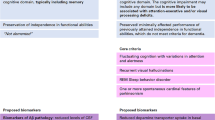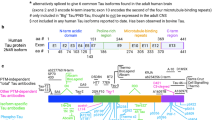Abstract
Purpose
The goal was to identify molecular imaging probes that would enter the brain, selectively bind to Parkinson’s disease (PD) pathology, and be detectable with one or more imaging modalities.
Procedure
A library of organic compounds was screened for the ability to bind hallmark pathology in human Parkinson’s and Alzheimer’s disease tissue, alpha-synuclein oligomers and inclusions in two cell culture models, and alpha-synuclein aggregates in cortical neurons of a transgenic mouse model. Finally, compounds were tested for blood–brain barrier permeability using intravital microscopy.
Results
Several lead compounds were identified that bound the human PD pathology, and some showed selectivity over Alzheimer’s pathology. The cell culture models and transgenic mouse models that exhibit alpha-synuclein aggregation did not prove predictive for ligand binding. The compounds had favorable physicochemical properties, and several were brain permeable.
Conclusions
Future experiments will focus on more extensive evaluation of the lead compounds as PET ligands for clinical imaging of PD pathology.






Similar content being viewed by others
References
de Lau LM, Breteler MM (2006) Epidemiology of Parkinson's disease. Lancet Neurol 5:525–535
Stoessl AJ (2012) Neuroimaging in Parkinson's disease: from pathology to diagnosis. Parkinsonism Relat Disord 18(Suppl 1):S55–9
Varrone A, Toth M, Steiger C et al (2011) Kinetic analysis and quantification of the dopamine transporter in the nonhuman primate brain with 11C-PE2I and 18F-FE-PE2I. J Nucl Med 52:132–139
Sasaki T, Ito H, Kimura Y et al (2012) Quantification of dopamine transporter in human brain using PET with 18F-FE-PE2I. J Nucl Med 53:1065–1073
Varrone A, Halldin C (2010) Molecular imaging of the dopamine transporter. J Nucl Med 51:1331–1334
Hurley MJ, Mash DC, Jenner P (2003) Markers for dopaminergic neurotransmission in the cerebellum in normal individuals and patients with Parkinson's disease examined by RT-PCR. Eur J Neurosci 18:2668–2672
Bacskai BJ, Hickey GA, Skoch J et al (2003) Four-dimensional multiphoton imaging of brain entry, amyloid binding, and clearance of an amyloid-beta ligand in transgenic mice. Proc Natl Acad Sci U S A 100:12462–12467
Klunk WE, Engler H, Nordberg A et al (2004) Imaging brain amyloid in Alzheimer's disease with Pittsburgh Compound-B. Ann Neurol 55:306–319
Klunk WE, Engler H, Nordberg A et al (2003) Imaging the pathology of Alzheimer's disease: amyloid-imaging with positron emission tomography. Neuroimaging Clin N Am 13:781–789
Klunk WE, Lopresti BJ, Ikonomovic MD et al (2005) Binding of the positron emission tomography tracer Pittsburgh compound-B reflects the amount of amyloid-beta in Alzheimer's disease brain but not in transgenic mouse brain. J Neurosci 25:10598–10606
Mathis CA, Mason NS, Lopresti BJ, Klunk WE (2012) Development of positron emission tomography beta-amyloid plaque imaging agents. Semin Nucl Med 42:423–432
McKeith IG, Galasko D, Kosaka K et al (1996) Consensus guidelines for the clinical and pathologic diagnosis of dementia with Lewy bodies (DLB): report of the consortium on DLB international workshop. Neurology 47:1113–1124
Cantuti-Castelvetri I, Klucken J, Ingelsson M et al (2005) Alpha-synuclein and chaperones in dementia with Lewy bodies. J Neuropathol Exp Neurol 64:1058–1066
Mathis CA, Wang Y, Holt DP et al (2003) Synthesis and evaluation of 11C-labeled 6-substituted 2-arylbenzothiazoles as amyloid imaging agents. J Med Chem 46:2740–2754
Payton JE, Perrin RJ, Clayton DF, George JM (2001) Protein–protein interactions of alpha-synuclein in brain homogenates and transfected cells. Brain Res Mol Brain Res 95:138–145
McLean PJ, Kawamata H, Hyman BT (2001) Alpha-synuclein-enhanced green fluorescent protein fusion proteins form proteasome sensitive inclusions in primary neurons. Neuroscience 104:901–912
Wakabayashi K, Engelender S, Yoshimoto M et al (2000) Synphilin-1 is present in Lewy bodies in Parkinson's disease. Ann Neurol 47:521–523
Outeiro TF, Putcha P, Tetzlaff JE et al (2008) Formation of toxic oligomeric alpha-synuclein species in living cells. PLoS One 3:e1867
Danzer KM, Ruf WP, Putcha P et al (2011) Heat-shock protein 70 modulates toxic extracellular alpha-synuclein oligomers and rescues trans-synaptic toxicity. FASEB J 25:326–336
Unni VK, Weissman TA, Rockenstein E et al (2010) In vivo imaging of alpha-synuclein in mouse cortex demonstrates stable expression and differential subcellular compartment mobility. PLoS One 5:e10589
Rockenstein E, Schwach G, Ingolic E et al (2005) Lysosomal pathology associated with alpha-synuclein accumulation in transgenic models using an eGFP fusion protein. J Neurosci Res 80:247–259
Skoch J, Hickey GA, Kajdasz ST et al (2005) In vivo imaging of amyloid-beta deposits in mouse brain with multiphoton microscopy. Methods Mol Biol 299:349–363
Spires-Jones TL, de Calignon A, Meyer-Luehmann M et al (2011) Monitoring protein aggregation and toxicity in Alzheimer's disease mouse models using in vivo imaging. Methods 53:201–207
Edelstein A, Amodaj N, Hoover K, et al. (2010) Computer control of microscopes using microManager. Curr Protoc Mol Biol Chapter 14:Unit14.20
Schneider CA, Rasband WS, Eliceiri KW (2012) NIH Image to ImageJ: 25 years of image analysis. Nat Methods 9:671–675
Swaminathan S, Shen L, Risacher SL et al (2012) Amyloid pathway-based candidate gene analysis of [(11)C]PiB-PET in the Alzheimer's Disease Neuroimaging Initiative (ADNI) cohort. Brain Imaging Behav 6:1–15
Dishino DD, Welch MJ, Kilbourn MR, Raichle ME (1983) Relationship between lipophilicity and brain extraction of C-11-labeled radiopharmaceuticals. J Nucl Med 24:1030–1038
Acknowledgments
Many thanks to Julia George, University of Illinois, for the H3C Antibody and to Eliezer Masliah, UCSD, for the Syn-GFP mouse model.
Funding
Michael J. Fox Foundation and NIH AG026240.
Conflict of Interest
The authors declare that they have no conflict of interest.
Author information
Authors and Affiliations
Corresponding author
Additional information
Krista L. Neal and Naomi B. Shakerdge contributed equally to this work.
Electronic supplementary material
Below is the link to the electronic supplementary material.
ESM 1
(PDF 200 kb)
Rights and permissions
About this article
Cite this article
Neal, K.L., Shakerdge, N.B., Hou, S.S. et al. Development and Screening of Contrast Agents for In Vivo Imaging of Parkinson’s Disease. Mol Imaging Biol 15, 585–595 (2013). https://doi.org/10.1007/s11307-013-0634-y
Published:
Issue Date:
DOI: https://doi.org/10.1007/s11307-013-0634-y




